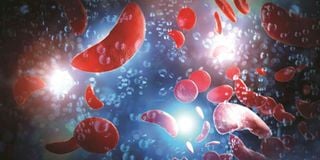Drive to curb sickle cell disease in Africa intensifies as Kenya bolsters prevention

Globally, it is estimated that sickle cell disease (SCD) accounts for between six and 15 percent of deaths among children aged less than five.
Nearly 1,000 children in Africa are born with sickle cell disease every day making it the most prevalent genetically-acquired disease in the region.
In Kenya, it is estimated that 14,000 children are born with sickle cell disease every year.
Sickle cell disease is an inherited blood disorder that shortens red blood cell survival causing anaemia.
Poor blood oxygen levels and blood vessel blockages in people with sickle cell disease can cause extreme pain in the back, chest, hands and feet as well as severe bacterial infections.
Due to the absence of newborn screening programmes and surveillance across the region, there is a lack of accurate and reliable data on the disease.
More than half of these children will die before they reach the age of five, usually from infection or severe anaemia due to the absence of routine newborn screening and appropriate treatment.
At least more than 66 percent, or more than 80million people of the 120 million people affected worldwide by sickle cell disease, live in Africa.
According to WHO, in the African region, 38 403 deaths from sickle cell disease were recorded in 2019, a 26 percent increase from 2000.
In Kenya, the Ministry of Health is implementing health system reforms aimed at accelerating control interventions for sickle cell disease in the country with policy guidelines for infant screening set to be launched.
The Ministry of Health has established a National Multi-sectoral and Multi-Stakeholder Technical Working Group to step up advocacy, screening, diagnosis, care and treatment and data, surveillance and research.
Chief Administrative Secretary (CAS) for Health, Dr Rashid Aman said the guidelines will be implemented in phases to ensure that infants are screened and linked to care.
"Devolved units must invest more in sickle cell disease, including procuring sufficient medicines, supplies and technologies for screening, diagnosis and management for the condition," said Dr Rashid.
The disease is common across Kenya, affecting 18 counties, with high disease burden pockets in Western, Nyanza and Coastal regions.
The burden of sickle cell stems from low investment in the efforts to combat the disease. Many public health facilities across the region lack the services for prevention, early detection and care for sickle cell disease.
Inadequate personnel and lack of services at lower-level health facilities also hamper effective response to the disease.
The latest World Health Organization (WHO) Regional Committee for Africa report says the only way to fight the disease is to enhance advocacy, shore up political will and engagement as well as financial resources for the prevention and control of one of the most common illnesses in the region.
The diseases receive inadequate attention and this has prompted the African health ministers to launch a campaign to ramp up awareness and bolster prevention and care to curb the toll of sickle cell disease.
The new campaign is being supported by partners including the World Bank, the United States Department of Human and Health Services, Novartis Foundation, Global Blood Therapeutics and Sickle in Africa.
The campaign launched at a side-event on enhancing advocacy on sickle cell disease during the 72nd session in Lome, Togo on August 22 aims at tackling measures to lower the burden of diseases, seek ways to curb the drivers of ill health and endorse strategies to promote access to health services and people's well-being.
It also seeks to raise public awareness of the disease in schools, communities, health institutions and the media and advocate stronger health systems to ensure quality and uninterrupted services and equitable access to medicines and innovative tools.
"Most African countries do not have the necessary resources to provide comprehensive care for people with sickle cell disease despite the availability of proven cost-effective interventions for prevention, early diagnosis and management of this condition," said Dr Matshidiso Moeti, WHO Regional Director for Africa.
"We need to shine the spotlight on this disease and help improve the quality of life of those living with it. We can no longer ignore the significant burden caused by sickle cell disease," said Dr Moeti.
"We must do more to improve access to treatment and care, including counselling and newborn screening by ensuring that programmes are decentralized and integrated with services being delivered to communities and at primary health care level."
Dr Moeti stressed the need for greater investment and stronger collaboration and partnerships to help stem the tide of rising cases of sickle cell disease in Africa.
The missing link in the fight against the disease includes the lack of data collection which is not included in most national population-wide surveys.
These data gaps have negatively impacted the prioritisation and allocation of resources for the disease.
Beyond its public health impact, sickle cell disease also poses numerous economic and social costs for those affected and their families and can interfere with many aspects of patients' lives, including education, employment, mental and social well-being and development.




